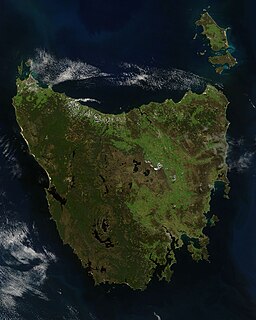
The Tasmanian temperate rain forests are part of the Australasia ecozone, which includes Tasmania and Australia, New Zealand, New Guinea, New Caledonia, and adjacent islands.
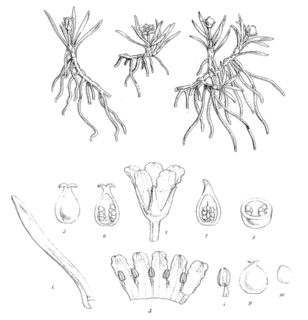
Liparophyllum gunnii, commonly known as alpine marshwort, is a species of aquatic flowering plants in the family Menyanthaceae. It is the type for the genus Liparophyllum. It is a wetland plant having a rhizomatous root structure and alternate linear leaves. Its flowers occur singly, are five-petalled, and white. Flowers bud and open from December to February; fruits form from December through April. L. gunnii is indigenous to Tasmania and New Zealand.

Nothofagus gunnii, the tanglefoot- or deciduous beech, or fagus, is a deciduous shrub endemic to the highlands of Tasmania, Australia. It was discovered in 1847 by R.C Gunn and evidence exists that it once lived in Antarctica. N. gunnii is a small woody tree with a shrubby appearance known to grow up to 3 metres (9.8 ft). It lives only on mountains due to temperature limitations within the Tasmanian maritime climate and can survive up to heights of 1,400 metres (4,600 ft). It grows in alpine and sub-alpine regions in the west to central portions of the state but is absent from the mountains of the northeast. Though capable of reaching the size of a small tree, it rarely exceeds 2 metres (6.6 ft) in height, instead growing as a thick shrub or as a woody ground cover hence its common name of "tanglefoot".

Eucalyptus gunnii, commonly known as cider gum, is a species of small to medium-sized tree endemic to Tasmania. It has mostly smooth bark, lance-shaped to egg-shaped adult leaves, flower buds in groups of three, white flowers and cylindrical to barrel-shaped fruit.
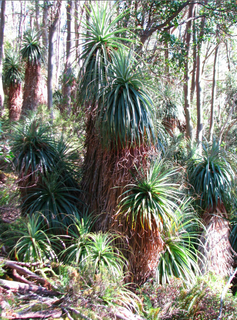
Richea pandanifolia, the pandani or giant grass tree, is a distinctive endemic Tasmanian angiosperm. It is dicot of the family Ericaceae and is found in central, western and south west Tasmania. It is a favourite among hikers and nature lovers.

Eucalyptus vernicosa, commonly known as varnished gum, is a species of shrub or a mallee that is endemic to mountainous areas of Tasmania. It has smooth greyish bark, crowded, egg-shaped to elliptical or round leaves, flower buds singly or in groups of three in leaf axils, white flowers and hemispherical or bell-shaped fruit.

Richea scoparia, is a wide spread Tasmanian endemic plant. The genus Richea, forms part of the Ericaceae family, which are commonly heath-like shrubs. The name refers to the erect bushy growth habit, described as a broom-like shrub, most commonly referred to as the honey bush or simply ‘scoparia’ to many bushwalkers.
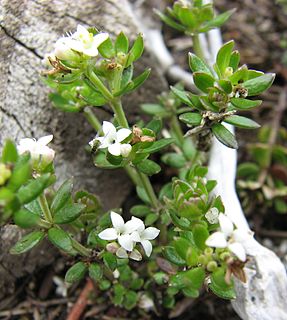
Asperula gunnii, the mountain woodruff, is a species of flowering plant in the family Rubiaceae. It is a perennial herb that is endemic to Australia.
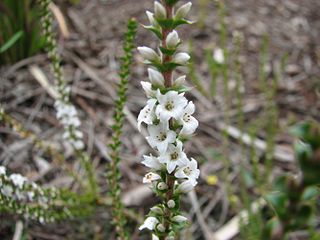
Epacris gunnii is a plant species endemic to Australia. It is a shrub comprising a few erect branches, growing up to 1 metre high. The leaves are 2 to 7 mm long and spaced evenly down most of the length of the branches. The white flowers are crowded at the top of branches, spreading down the branch for 20 to 30 cm. These are about 5 mm in diameter and appear between April and October in New South Wales and September to December in Tasmania.

Pittosporum bicolor, commonly known as cheesewood or banyalla, is a flowering shrub or small tree of the Pittosporaceae family, and is native to south eastern Australia.
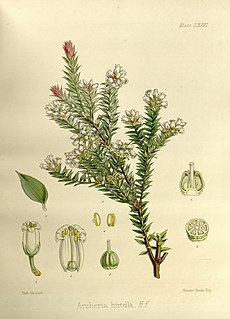
Archeria hirtella is a species of shrub in the family Ericaceae. It is native to Tasmania, Australia.

Persoonia gunnii, commonly known as the mountain geebung, is a slow-growing shrub endemic to wet forests and subalpine shrubberies in Tasmania. It forms a bush ranging from 0.6 to 3 m in height with short, up-curved leaves and scented cream-yellow flowers in summer giving way to small dark purple fruit. It is a common shrub in subalpine areas of the state and is occasionally confused with P. muelleri.

Persoonia muelleri, commonly known as Mueller’s geebung, is a shrub endemic to Tasmania. It forms a shrub in open areas of wet forests in the west and northeast of the state. It is occasionally confused with P. gunnii though it has larger flowers and longer, straighter leaves.

Orites revolutus , also known as narrow-leaf orites, is a Tasmanian endemic plant species in the family Proteaceae. Scottish botanist Robert Brown formally described the species in Transactions of the Linnean Society of London in 1810 from a specimen collected at Lake St Clair. Abundant in alpine and subalpine heath, it is a small to medium shrub 0.5 to 1.5 m tall, with relatively small, blunt leaves with strongly revolute margins. The white flowers grow on terminal spikes during summer. Being proteaceaous, O. revolutus is likely to provide a substantial food source for nectivorous animal species within its range.
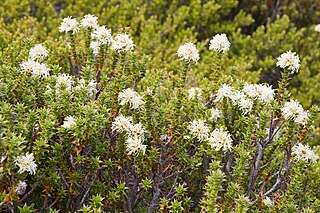
Richea sprengelioides is a species of flowering plant in the family Ericaceae. It is one of the 11 species within the genus Richea that are endemic to Australia, of which 9 are found only in Tasmania.
Melaleuca pustulata, commonly known as yellow paperbark, warty paperbark or Cranbrook paperbark is a plant in the myrtle family, Myrtaceae and is endemic to Tasmania in Australia. It is an uncommon shrub, one of only two melaleucas that are endemic to that state and one of only eight found naturally occurring there. It has thick, pimply leaves, hairy new growth and large numbers of heads of pale yellow, fragrant flowers in spring or early summer.
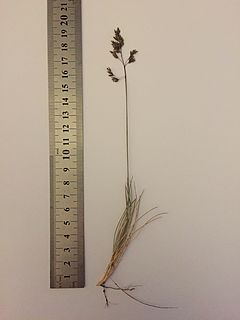
Poa gunnii is a Tasmanian endemic tussock grass considered one of the most abundant and common in alpine and subalpine environments from about 800 m to above 1400 m. However it can be found to near sea level in the south of the island state where a cooler climate is prevalent. The genus Poa belongs to the family Poaceae. Tasmania has 16 native and 6 introduced species of Poa.

Actinotus suffocatus, the crimson flannelflower, is a small, perennial herb endemic to the Australian State of Tasmania. It is primarily found in high-elevation habitats in wet situations, except in the far south-west of the island, where it occurs down to sea level in continually moist habitats.
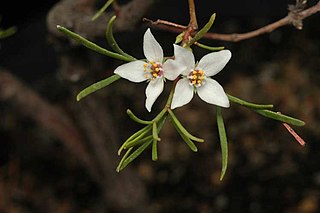
Boronia gunnii, commonly known as Gunn's boronia or Cataract Gorge boronia is a plant in the citrus family Rutaceae and is endemic to Tasmania. It is an erect shrub with compound leaves and pink or white, four-petalled flowers.
Monotoca glauca, known as goldy wood, is a heath family shrub endemic to Tasmania, Australia and is one of 17 described Monotoca species. It is a widespread and abundant understory species found on the margins of wet eucalypt forests and logged areas.


















